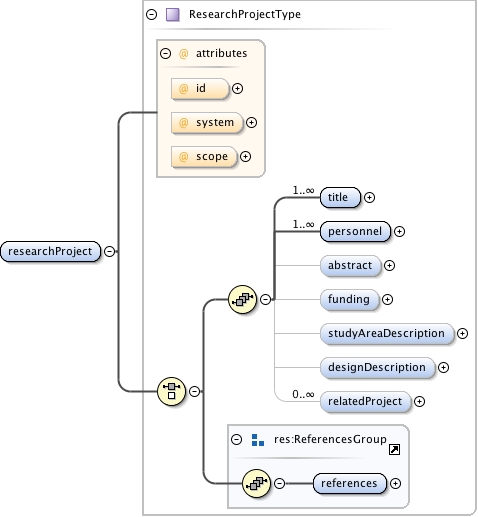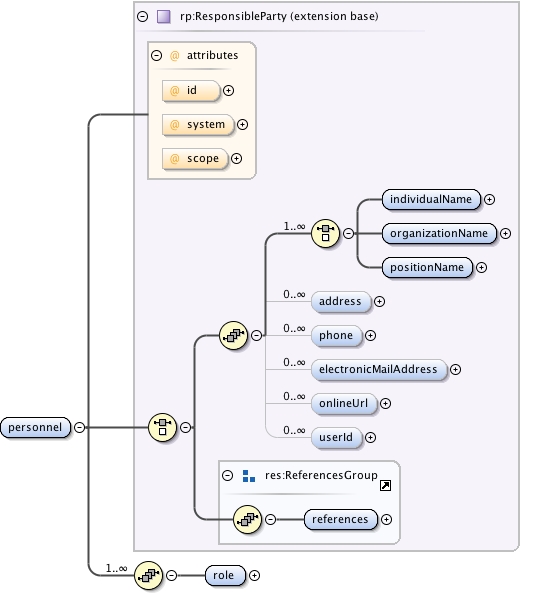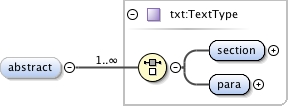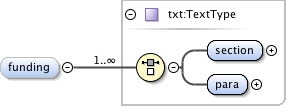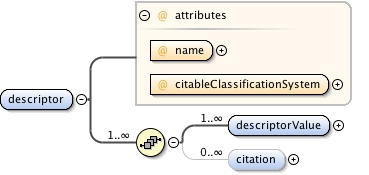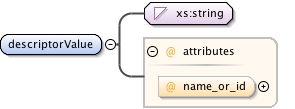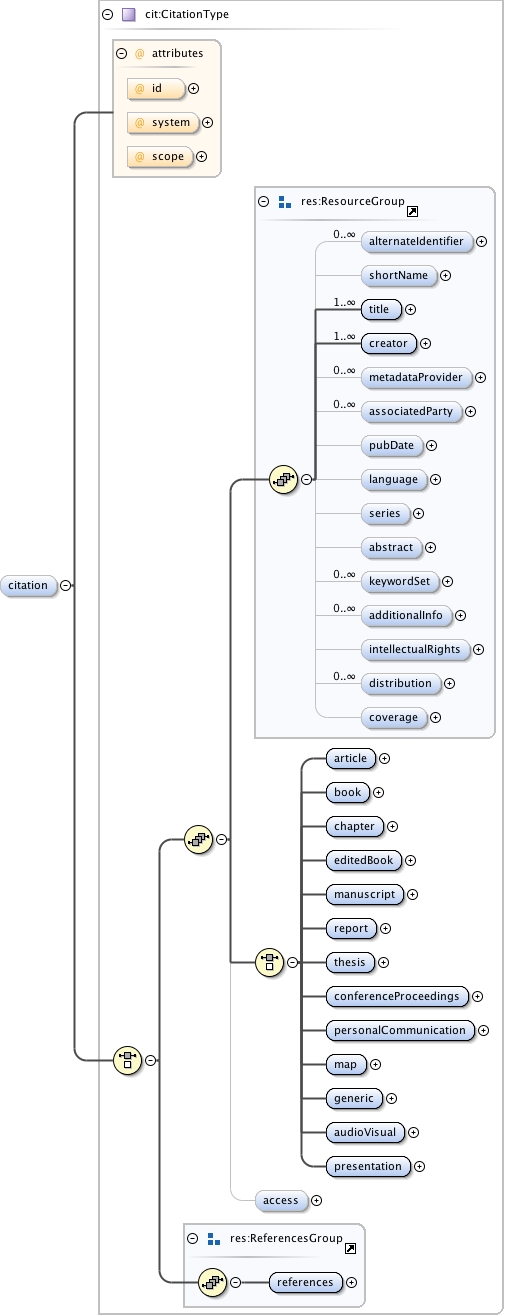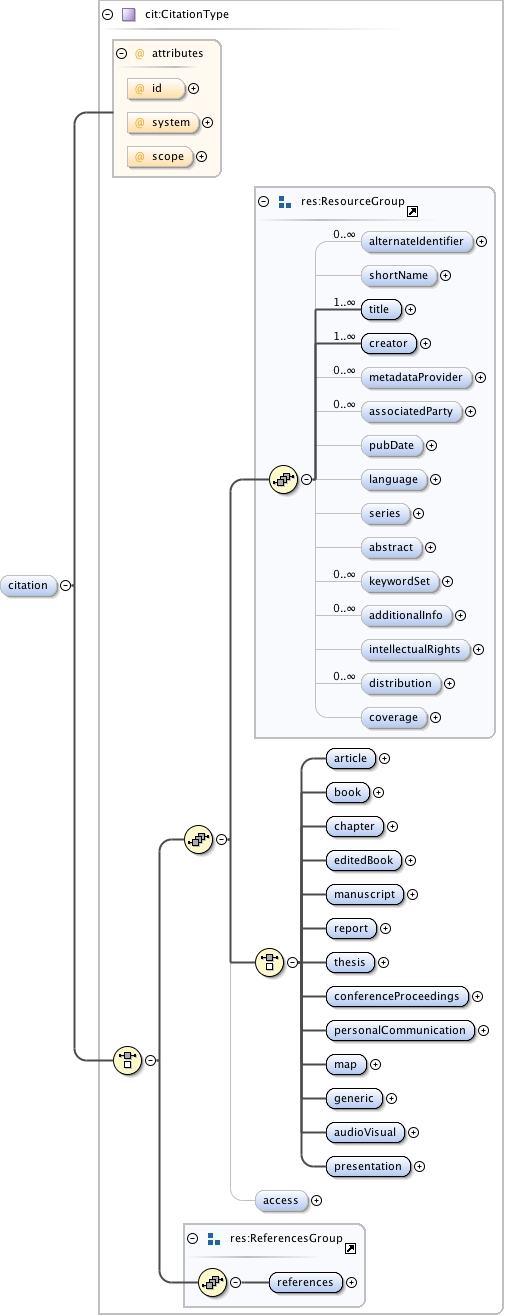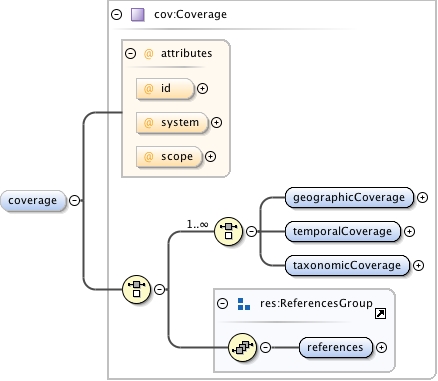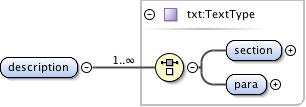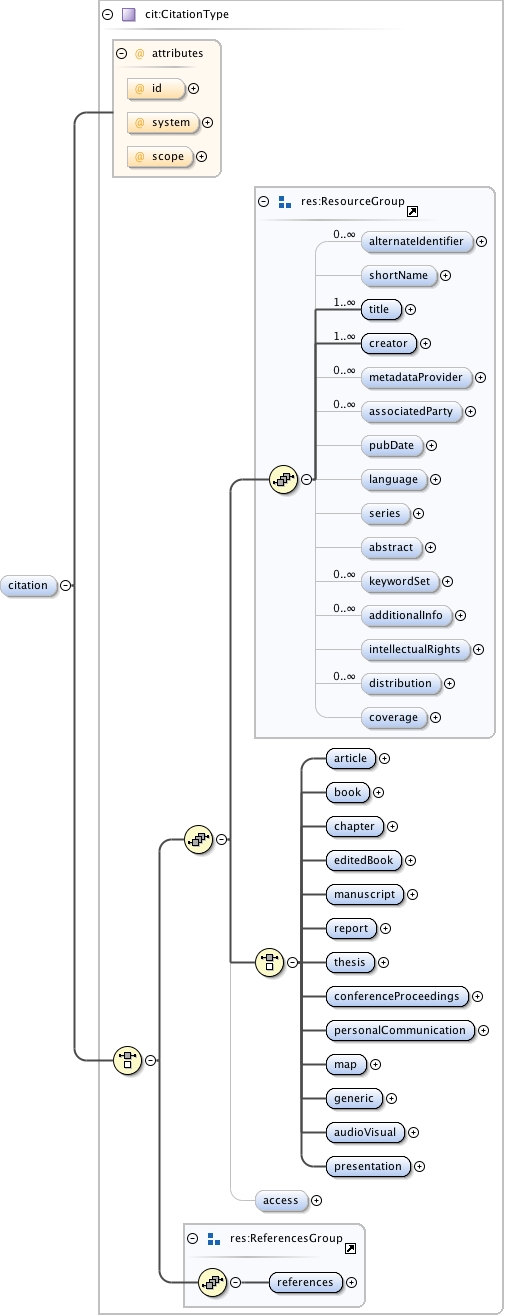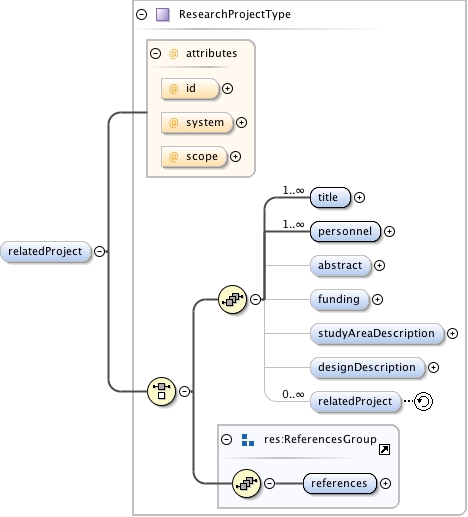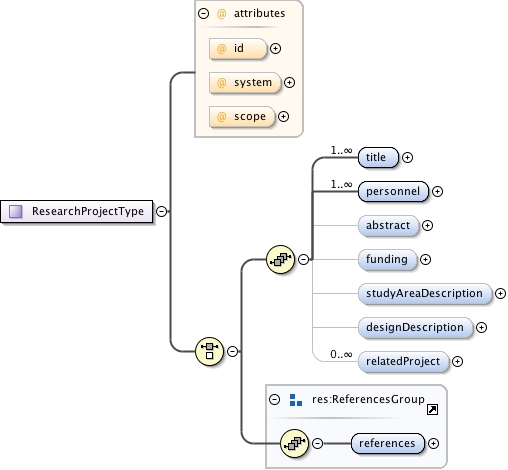<xs:complexType name="ResearchProjectType">
<xs:annotation>
<xs:appinfo>
<doc:tooltip>Research project descriptor</doc:tooltip>
<doc:summary>Descriptor of a research context for a dataset or another
project.</doc:summary>
<doc:description>The researchProject complex type describes the
structure for documenting the research context of a dataset or another
project. It can include research goals, motivations, theory,
hypotheses, etc., as well as a description of research efforts that
form the basis for other work. (To document methods specific to a
dataset use eml-methods.) This field can be associated with a dataset
using the project field of eml-dataset, and can be associated with
another project using the relatedProject field of eml-project (this
module).</doc:description>
</xs:appinfo>
</xs:annotation>
<xs:choice>
<xs:sequence>
<xs:element name="title" type="xs:string" maxOccurs="unbounded">
<xs:annotation>
<xs:appinfo>
<doc:tooltip>Project Title</doc:tooltip>
<doc:summary>Title of the project.</doc:summary>
<doc:description>A descriptive title for the research
project.</doc:description>
<doc:example>Species diversity in Tennessee riparian
habitats.</doc:example>
</xs:appinfo>
</xs:annotation>
</xs:element>
<xs:element name="personnel" maxOccurs="unbounded">
<xs:annotation>
<xs:appinfo>
<doc:tooltip>Personnel</doc:tooltip>
<doc:summary>Contact and role information for people involved in
the research project.</doc:summary>
<doc:description>The Personnel field extends ResponsibleParty
with role information and is used to document people involved in
a research project by providing contact information and their
role in the project. A project must have at least one
originator.</doc:description>
</xs:appinfo>
</xs:annotation>
<xs:complexType>
<xs:complexContent>
<xs:extension base="rp:ResponsibleParty">
<xs:sequence maxOccurs="unbounded">
<xs:element name="role" type="rp:RoleType">
<xs:annotation>
<xs:appinfo>
<doc:tooltip>Role</doc:tooltip>
<doc:summary>Role information for people involved in
the research project.</doc:summary>
<doc:description>The role field contains information
about role a person plays in a research project. There
are a number of suggested roles, however, it is
possible to add a role if the suggested roles are not
adequate.</doc:description>
<doc:example>author</doc:example>
<doc:example>contentProvider</doc:example>
<doc:example>custodianSteward</doc:example>
<doc:example>distributor</doc:example>
<doc:example>editor</doc:example>
<doc:example>metadataProvider</doc:example>
<doc:example>originator</doc:example>
<doc:example>owner</doc:example>
<doc:example>pointOfContact</doc:example>
<doc:example>principalInvestigator</doc:example>
<doc:example>processor</doc:example>
<doc:example>publisher</doc:example>
<doc:example>user</doc:example>
<doc:example>fieldStationManager</doc:example>
<doc:example>informationManager</doc:example>
</xs:appinfo>
</xs:annotation>
</xs:element>
</xs:sequence>
</xs:extension>
</xs:complexContent>
</xs:complexType>
</xs:element>
<xs:element name="abstract" type="txt:TextType" minOccurs="0">
<xs:annotation>
<xs:appinfo>
<doc:tooltip>Abstract</doc:tooltip>
<doc:summary>Project Abstract.</doc:summary>
<doc:description>Descriptive abstract that summarizes information
about the research project.</doc:description>
</xs:appinfo>
</xs:annotation>
</xs:element>
<xs:element name="funding" type="txt:TextType" minOccurs="0">
<xs:annotation>
<xs:appinfo>
<doc:tooltip>Funding</doc:tooltip>
<doc:summary>Funding information.</doc:summary>
<doc:description>The funding field is used to provide information
about funding sources for the project such as: grant and contract
numbers; names and addresses of funding sources. Other
funding-related information may also be
included.</doc:description>
</xs:appinfo>
</xs:annotation>
</xs:element>
<xs:element name="studyAreaDescription" minOccurs="0">
<xs:annotation>
<xs:appinfo>
<doc:tooltip>Description of the study area.</doc:tooltip>
<doc:summary>Description of the physical area associated with the
research project, potentially including coverage, climate,
geology, distrubances, etc.</doc:summary>
<doc:description>The studyAreaDescription field documents the
physical area associated with the research project. It can
include descriptions of the geographic, temporal, and taxonomic
coverage of the research location and descriptions of domains
(themes) of interest such as climate, geology, soils or
distrubances or reference to citable biological or geophysical
classification systems such as the Bailey Ecoregions or the
Holdridge Life Zones.</doc:description>
</xs:appinfo>
</xs:annotation>
<xs:complexType>
<xs:choice maxOccurs="unbounded">
<xs:element name="descriptor">
<xs:annotation>
<xs:appinfo>
<doc:tooltip>Non-coverage characteristics of the study
area</doc:tooltip>
<doc:summary>Description of non-coverage characteristics of
the study area such as climate, geology,
disturbances</doc:summary>
<doc:description>The descriptor field is used to document
domains (themes) of interest such as climate, geology,
soils or disturbances or references to citable biological
or geophysical classification systems such as the Bailey
Ecoregions or the Holdridge Life Zones.</doc:description>
</xs:appinfo>
</xs:annotation>
<xs:complexType>
<xs:sequence maxOccurs="unbounded">
<xs:element name="descriptorValue" maxOccurs="unbounded">
<xs:annotation>
<xs:appinfo>
<doc:tooltip>Description of some aspect of the study
area.</doc:tooltip>
<doc:summary>Description of some aspect of the study
area.</doc:summary>
<doc:description>The descriptorValue field contains
the value of a descriptor, describing some aspect of
the study area. This may either be a general
description in textual form or the value part of a
"name/value" pair where the name is entered in the
attribute "name_or_id". For example, if the value of
the "name" attribute" of the element "descriptor" is
"climate", and the value of the attribute
"name_or_id" of the element "descriptorValue" is
"Annual Precipitation" then the value of this element
could be "12.5 inches".</doc:description>
<doc:example>12.5 inches</doc:example>
<doc:example>tundra-forest</doc:example>
</xs:appinfo>
</xs:annotation>
<xs:complexType>
<xs:simpleContent>
<xs:extension base="xs:string">
<xs:attribute name="name_or_id" type="xs:string" use="optional">
<xs:annotation>
<xs:appinfo>
<doc:tooltip>The name or ID of a descriptor
value.</doc:tooltip>
<doc:summary>The name part of a name/value
pair of a descriptor; or ID portion of a
classification, if applicable.</doc:summary>
<doc:description>The name_or_id field is the
name part of a name/value pair of a
descriptor; or ID portion of a
classification, if applicable. The values of
biogeophysical classification systems, e.g.
Bailey-Ecoregions, often take the form of an
ID or Code along with a text representaiton.
For example, the ID/Code M131 refers to the
phrase "Open Woodland -Tundra". M131 is an
unambiguous reference to a more detailed
description. If one is using a published
classification system then there should be a
corresponding citation to the source, e.g.,
Bailey,R.G., 1996 "Ecosystem
Geography".</doc:description>
<doc:example>M131</doc:example>
<doc:example>Average Annual
Rainfall</doc:example>
</xs:appinfo>
</xs:annotation>
</xs:attribute>
</xs:extension>
</xs:simpleContent>
</xs:complexType>
</xs:element>
<xs:element name="citation" type="cit:CitationType" minOccurs="0" maxOccurs="unbounded">
<xs:annotation>
<xs:appinfo>
<doc:tooltip>citation</doc:tooltip>
<doc:summary>A citation for this
descriptor.</doc:summary>
<doc:description>A citation for this
desciptor.</doc:description>
</xs:appinfo>
</xs:annotation>
</xs:element>
</xs:sequence>
<xs:attribute name="name" type="DescriptorType" use="required">
<xs:annotation>
<xs:appinfo>
<doc:tooltip>name</doc:tooltip>
<doc:summary>The name of the descriptor
system.</doc:summary>
<doc:description>The name of the descriptor system. The
name can be either a theme such as climate or
hydrology, or the name of a citable classification
system.</doc:description>
</xs:appinfo>
</xs:annotation>
</xs:attribute>
<xs:attribute name="citableClassificationSystem" type="xs:boolean" use="required">
<xs:annotation>
<xs:appinfo>
<doc:tooltip>citation classification
system</doc:tooltip>
<doc:summary>This boolean attribute defines whether
this descriptor comes from a citable classification
system or not.</doc:summary>
<doc:description>This boolean attribute defines whether
this descriptor comes from a citable classification
system or not.</doc:description>
</xs:appinfo>
</xs:annotation>
</xs:attribute>
</xs:complexType>
</xs:element>
<xs:element name="citation" type="cit:CitationType" minOccurs="0">
<xs:annotation>
<xs:appinfo>
<doc:tooltip>citation</doc:tooltip>
<doc:summary>The citation for this
descriptor.</doc:summary>
<doc:description>The citation for this
descriptor.</doc:description>
</xs:appinfo>
</xs:annotation>
</xs:element>
<xs:element name="coverage" type="cov:Coverage" minOccurs="0">
<xs:annotation>
<xs:appinfo>
<doc:tooltip>coverage</doc:tooltip>
<doc:summary>The coverage of this descriptor.</doc:summary>
<doc:description>The coverage of this
descriptor.</doc:description>
</xs:appinfo>
</xs:annotation>
</xs:element>
</xs:choice>
</xs:complexType>
</xs:element>
<xs:element name="designDescription" minOccurs="0">
<xs:annotation>
<xs:appinfo>
<doc:tooltip>Description of research design</doc:tooltip>
<doc:summary>Description of the design of the research
project</doc:summary>
<doc:description>The field designDescription contains general
textual descriptions of research design. It can include detailed
accounts of goals, motivations, theory, hypotheses, strategy,
statistical design, and actual work. Literature citations may
also be used to describe the research design.</doc:description>
</xs:appinfo>
</xs:annotation>
<xs:complexType>
<xs:choice maxOccurs="unbounded">
<xs:element name="description" type="txt:TextType">
<xs:annotation>
<xs:appinfo>
<doc:tooltip>Description of research design</doc:tooltip>
<doc:summary>Textual description of research
design.</doc:summary>
<doc:description>The field designDescription contains
general textual descriptions of research design. It can
include detailed accounts of goals, motivations, theory,
hypotheses, strategy, statistical design, and actual
work.</doc:description>
</xs:appinfo>
</xs:annotation>
</xs:element>
<xs:element name="citation" type="cit:CitationType" minOccurs="0">
<xs:annotation>
<xs:appinfo>
<doc:tooltip>Citation for research design</doc:tooltip>
<doc:summary>Citation that describes the research
design.</doc:summary>
<doc:description>The citation field is a citation to
literature that describes elements of the research design,
such as goals, motivations, theory, hypotheses, strategy,
statistical design, and actual work.</doc:description>
</xs:appinfo>
</xs:annotation>
</xs:element>
</xs:choice>
</xs:complexType>
</xs:element>
<xs:element name="relatedProject" type="ResearchProjectType" minOccurs="0" maxOccurs="unbounded">
<xs:annotation>
<xs:appinfo>
<doc:tooltip>related project</doc:tooltip>
<doc:summary>This field is a recursive link to another
project.</doc:summary>
<doc:description>This field is a recursive link to another
project. This allows projects to be nested under one another for
the case where one project spawns another.</doc:description>
</xs:appinfo>
</xs:annotation>
</xs:element>
</xs:sequence>
<xs:group ref="res:ReferencesGroup"/>
</xs:choice>
<xs:attribute name="id" type="res:IDType" use="optional"/>
<xs:attribute name="system" type="res:SystemType" use="optional"/>
<xs:attribute name="scope" type="res:ScopeType" use="optional" default="document"/>
</xs:complexType> |
